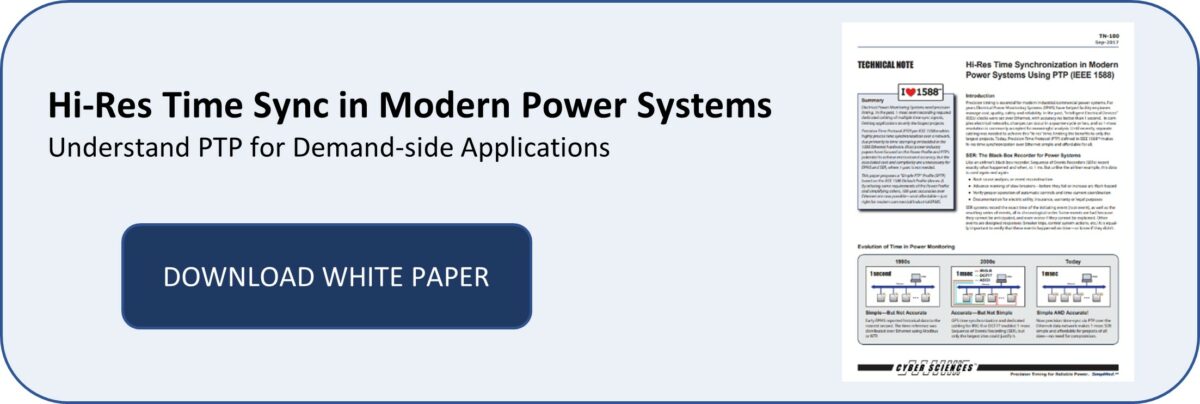Cyber Sciences Blog Series
Advantages of Implementing
High Precision Time Synchronization

Power outages continue to challenge every segment of the US economy. The Lawrence Berkeley National Laboratory (Berkeley Lab) developed an Interruption Cost Estimate calculator to help assess the economic cost of power outages in the United States. The calculator models data obtained from thirty-four utility customer interruption cost surveys and provides users an online tool for estimating the impact of future outages.
The Berkeley Lab studies estimate that severe weather-related interruptions cost utility customers $2 to $3 billion in any given year. Power interruptions cost the overall US economy $5 to $75 billion annually. Data centers, hospitals, transportation venues (airports, subways, etc.), hotels, and universities are all vulnerable to significant losses.1
Whether a power outage will occur is not a question of “if” but “when” and “how often.” Although most critical facilities are designed to avoid downtime due to an outage, none are entirely failproof. A power distribution system (PDS) that is time-synchronized to an accurate clock dramatically improves the accuracy of its’ data. Therefore when an outage occurs, information is provided to follow the sequence of events that caused the outage and is available for analysis to pinpoint exactly where and why it started. The quality of information a time-synchronized PDS delivers is crucial for precise documentation of the event and, more importantly, enabling a quick recovery.
But Precision Timing Is Essential

It’s easy to understand how outages caused by hurricanes, ice storms, and other severe weather events can lead to power interruptions at a facility. However, exactly when it occurred and how it cascaded throughout the facility remains the question. Not all interruptions in utility power are tied to natural events. Having reliable documentation of the source and timing of an event to provide back to a utility can help resolve disputes quicky. Internal factors which lead to an incident are sometimes harder to determine. The failure could be the fault of an automatic transfer switch that does not transfer to emergency standby power when utility power fails. It could be a circuit breaker opening prematurely and creating a potentially catastrophic failure. Or it could simply be human error — which accounts for 22% of outages in facilities such as data centers.2 Sequence of Events Recorders (SERs) coupled with an Event Manager device can provide the tools needed to oversee systems which are crucial for facility operation.
For example, a SER monitoring up to 32 inputs from devices such as UPSs, circuit breakers, ATSs, and relays records the time and sequence of state changes (ON-to-OFF or OFF-to-ON) as they occur. As the input on a device changes status, the SER captures the change with a time stamp accurate to 1 ms. The Event Manager allows users to view data from multiple SERs at once providing a comprehensive view of all monitored statuses in the entire PDS. The Event Manager also has simple but powerful analytical tools to analyze data, making event reconstruction faster and easier. Having multiple SERs monitoring every status input of the electrical system and an Event Manager providing a high level view of the whole system, allows users to better anticipate and prevent power interruptions.
Unless every device clock or input monitoring device in the PDS is synchronized to a common time source, the timestamps recorded during an event will be useless. In other words, unless all aspects of a power outage are captured with accurate timestamps, there is no practical way to determine which event occurred first—therefore making it difficult to quickly conduct a root cause analysis or thorough investigation.
For that reason, SERs use millisecond timestamping with one millisecond precision, thereby capturing state changes that may otherwise appear to happen at the same time. SERs can also monitor devices without clocks such as breakers to provide a broader, more comprehensive picture of the incident, which eliminates blind spots.
Where Does the Time Standard Come From?
For critical power applications where multiple state changes can occur within a fraction of a 60 Hz cycle, the 1 ms interval resolution is required for meaningful post-event analysis. To accomplish this, multiple devices with different time protocols such as IRIG-B, 1per10 and DCF77 must be synchronized. Cyber Sciences’ products use technologies that work together to synchronize these devices throughout an entire power system. These technologies include Network Time Protocol (NTP), which has been in use since the mid-1980s. Precision Time Protocol (PTP, documented under the IEEE 1588 standard), is a more recent protocol that provides greater accuracy than NTP. It became available in 2002 and the IEEE has continued to improve it with the most recent enhancements being made in 2019. PTP delivers precise time synchronization within 100 microseconds over an existing Ethernet network, further reducing cost and complexity.3 Cyber Sciences’ products provides a simple yet cost effective method to utilize PTP and ensure precision time synchronization of all power system devices.
Conclusion
For those considering high-precision SERs and the advantages they deliver, keep these four takeaways in mind.
- To accurately reconstruct a power outage, even a momentary one, it is essential monitoring devices are synchronized to one time source.
- Precision timing matters. With millisecond precision, you can take the necessary steps to understand the cause of an outage or to prevent future outages.
- Cyber-Sciences products allow you to extend precision timing throughout the entire power distribution system regardless of the time protocols used by various devices.
- With Cyber Sciences products, extending precision timing throughout the power distribution system is simple, reliable, and cost effective.
To learn more about the products discussed in this blog, visit the following links.
SER-3200/2408 PTP SERs provide time synchronization and precision timed event status change of devices throughout the electrical power system.
Event Manager EM-100, provides the ability to view and monitor I/O status from multiple SERs in one easy-to-understand web interface.
STR-100 Satellite Time Reference, uses GPS technology to serve as a DCF-77 or IRIG-B master clock.




